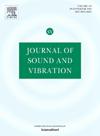Dynamic characteristics analysis of rotating variable thickness thin plates with setting angles including accurate centrifugal force via NCFFR
IF 4.3
2区 工程技术
Q1 ACOUSTICS
引用次数: 0
Abstract
Two novel dynamic models using nodal coordinate based floating frame of reference formulation (NCFFR) are proposed to investigate dynamic characteristics of rotating variable thickness thin plates with setting angles. Based on Lagrange's equations of the second kind and NCFFR, the dynamic equations of the rotating plates are derived, directly incorporating accurate centrifugal force and Coriolis force terms. Thereby avoiding the omission of such terms that may occur in absolute nodal coordinate formulation (ANCF) based modal calculations. Compared to the conventional floating frame of reference (FFR) method, NCFFR leverages the advantages of ANCF by accounting for the effects of steady-state deformation on modal properties. The convergence and validation analyses are compared with existing literature. The vibration characteristics of the blade during smooth operation are revealed through fast Fourier transform (FFT). The results show that the first-order mode of the rotating thin plate is excited under steady-state uniform rotation, leading to deformation dominated by this mode. And the increased rotational angular velocity shifts the system's frequency response resonance region (the ratio excitation frequency to first-order natural frequency) to higher. The torsional deformation of the rotating plate is triggered by the setting angles. Variable thickness plates enhance out-of-plane bending stiffness and reduce in-plane torsional stiffness, resulting in higher natural frequencies for out-of-plane modes compared to uniform plates.
求助全文
约1分钟内获得全文
求助全文
来源期刊

Journal of Sound and Vibration
工程技术-工程:机械
CiteScore
9.10
自引率
10.60%
发文量
551
审稿时长
69 days
期刊介绍:
The Journal of Sound and Vibration (JSV) is an independent journal devoted to the prompt publication of original papers, both theoretical and experimental, that provide new information on any aspect of sound or vibration. There is an emphasis on fundamental work that has potential for practical application.
JSV was founded and operates on the premise that the subject of sound and vibration requires a journal that publishes papers of a high technical standard across the various subdisciplines, thus facilitating awareness of techniques and discoveries in one area that may be applicable in others.
 求助内容:
求助内容: 应助结果提醒方式:
应助结果提醒方式:


